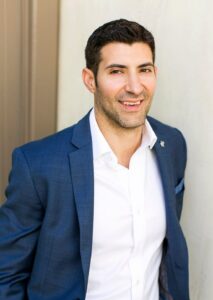Making Something From Nothing: Sarah Guilliot Of Sarah Design Agency On How To Go From Idea To Launch
An Interview With Fotis Georgiadis
… Your friends will be the first to buy from you. When I started to fill my pipeline with customers, I thought I had to go looking for all new people in all new places. Much to my delight, the first people to buy were the ones I loved most. My close friendships that I’ve been building for years turned into my first clients. They already trusted me. Once I started talking about my new offers and new ways I could serve them, they were thrilled to hire me to help.
As a part of our series called “Making Something From Nothing”, I had the pleasure of interviewing Sarah Guilliot.
Sarah Guilliot is a Designer and Coach with 20 years of experience in Web/UX Design, Copywriting, and Positioning. She’s created sales pages, site architecture, and advertising campaigns for Fortune 500 and tech companies such as Microsoft, GoDaddy, and T-Mobile.
Sarah currently runs an agency at www.sarahdesign.com where she creates client-attracting websites and marketing for Business Coaches and Service Providers with her no-stress copywriting and design service.
Thank you so much for doing this with us! Before we dive in, our readers would love to learn a bit more about you. Can you tell us a bit about your “childhood backstory”?
I was a quiet kid. Always holed up in my bedroom with a huge stack of library books and art supplies. My parents would beg me to get outside, or even just watch some TV so I would leave my room! That’s where my love of art, design, and writing was born. When I would dream about my future career, it was always a toss-up between therapist (I’m a great listener!), journalist, and designer. I used to imagine myself getting a job at a big agency where I’d be presenting ad campaign ideas to fellow executives. It’s pretty funny to think that I pretty much fulfilled ALL of those dreams. I had a 20-year career in corporate presenting ideas to fellow executives and now I have my own agency where copywriting, design (and yes even my “therapist” skills) come into play with every client.
Can you please give us your favorite “Life Lesson Quote”? Can you share how that was relevant to you in your life?
Back in 2011, a speaker at a work conference mentioned the phrase, “Done is better than perfect.” This was a completely foreign concept to me and blew my mind! Perfectionism and fear of failing had held me back from so many things in my life up to that point. I realized that whenever fear took hold, I tried to plan and think my way to success and it never worked. The only way to make real steps forward with any goal is to set perfectionism aside and just take action.
In the early years of my design career, my projects took forever to complete because I tried to perfect every design in hopes that clients wouldn’t have changes. I thought they’d all celebrate and cheer over my perfect work — it’s so silly now to think back on this mindset! With growth and lots of trial and error, I learned that every client needs changes. Nothing comes out perfect on your first try. It’s only through creation, discussion (+ edits), and iteration that truly great work is created. “Perfecting” is done over time, collaboratively, as you and your work mature. It’s only since I’ve embraced taking messy action that true momentum has come into my life and business.
Is there a particular book, podcast, or film that made a significant impact on you? Can you share a story or explain why it resonated with you so much?
The Courage and Clarity Podcast, by Steph Crowder had a huge impact on me leaving corporate to pursue my online business dreams. It wasn’t any one particular episode that helped me, but rather a series of messages repeated in stories from her guests. Through Steph’s podcast, I learned that I can actually create new client prospects by sharing my knowledge generously. I started reaching out in Facebook groups, offering insights and advice, and even free coaching sessions. This led to deep conversations with other entrepreneurs which turned into new friends and new business opportunities. Nothing convinces someone to pay for your services faster than a demonstration of your services in action…as long as you’re good at what you do!
Steph also taught me the concept of “Take your next best step.” Whenever I was faced with a huge task list where everything seemed important, I learned to prioritize the list with the most urgent items at the top. This helped me drill down to my next best step, and I was off to the races! I continue to apply this concept to my calendar and task list weekly, to this day.
Ok super. Let’s now shift to the main part of our discussion. There is no shortage of good ideas out there. Many people have good ideas all the time. But people seem to struggle in taking a good idea and translating it into an actual business. Can you share a few ideas from your experience about how to overcome this challenge?
Sure thing! In my work, I often help people launch courses. They’re usually booked-out service providers or coaches who are excellent at what they do one-on-one with clients. They feel like they understand their clients’ wants and needs better than the clients themselves do. So it’s a natural next step to turn those one-on-one lessons and expertise into course materials to sell in a one-to-many model.
This works great if they’re right about what their ideal client needs, but sometimes they’re wrong! The best way to overcome this challenge is to ASK clients what they need and want and create that for them. I’ve seen really talented and whip-smart leaders build entire courses (or entire businesses) off of assumptions and get it totally wrong. It’s not unreasonable to think that if you help people face-to-face with issues, then you know what they need. But it’s risky to invest a ton of time and money into building out a solution before you’ve validated that it will actually sell. Some services only work one-on-one and fall apart in a group setting. Or, the type of person who buys that one-on-one service would never purchase a DIY offering.
One of my colleagues tried to sell something they were SURE would sell (without asking clients) and it completely failed. Then when they followed my advice to test and validate their ideas with real people using real money, they hit huge revenue goals with ease!
The key to validating your idea is to “pre-sell” your course or offer. I know it sounds wild if you’ve never heard of this concept but it’s actually quite normal and smart to do.
How this works is, first you ask your current clients if what you have in mind would be helpful to them. If they say no, that’s great news! It means you haven’t wasted any time or money on an idea that won’t sell.
The next step would be to ask them why it’s not a great idea, and dig deep to find out what they really do need. Once you’ve identified something that feels solid, with clients saying “Yeah I’d totally buy that!” then you pre-sell it. You do that by reaching out to those same people and saying “Hey, I’m putting that thing together that we discussed. I have an outline of what will be included [ link to the outline ] and am releasing it approximately [ insert your date ], but I’m not creating it unless I get [ X number of ] people signed up. It’s a special price for founding members, and anyone who gets in on the ground floor will get all the updates and bonuses every time I re-launch it going forward. You in?”
Then give them a link to buy the course. Your offer idea is never really validated until someone pays for it, so this step is critical. If they don’t buy, then you go back to the drawing board on ideas. This is a far better path than heavily investing energy and finances into an idea you assume will sell, only to find out months later that you were wrong.
Often when people think of a new idea, they dismiss it saying someone else must have thought of it before. How would you recommend that someone go about researching whether or not their idea has already been created?
I can almost guarantee that your idea has been thought of before. If someone else is selling something similar (best if it’s not identical), then that proves there’s an audience for it. This is a good thing because you’ll know for a fact that people need what you’re selling.
I suggest you start by asking friends and family if they’ve seen this solution elsewhere. Then do some searching on Google, YouTube, and places like Reddit, or Pinterest. You can also look on Amazon for books relating to that topic, and even read the reviews of those books to see if people mention similar solutions there.
You don’t want to infringe on anyone else’s copyright or trademarks, but it’s good to know the competitive landscape before you begin. Don’t let someone else’s similar (and pre-existing) idea stop you from diving in with yours though! Two people selling the same thing are still unique and attract different people. Your idea and how you present it is closely intertwined with you as a person. When someone is given a choice of who to buy a similar product from, it’s the PERSON (the seller) who breaks the tie (or the personality of the brand if you’re a larger organization). If people like you and everything you stand for, they’ll choose you every time.
For the benefit of our readers, can you outline the steps one has to go through, from when they think of the idea, until it finally lands in a customer’s hands? In particular, we’d love to hear about how to file a patent, how to source a good manufacturer, and how to find a retailer to distribute it.
My clients sell digital products and services, not physical ones, so I can speak to the virtual side of the equation. It really all comes down to those validation tips I shared earlier. You want to have real conversations with real people about what their struggles are. What do they wake up at 3:00 in the morning in a panic over? Identify what they need or desire and find a way to bridge that gap for them.
Create the outline of a solution (an online course or new service, for example) and show it to them for feedback. Get their buy-in, literally, by selling it to them before you create it. Then make it, give it to them, and follow up to see how it went and how to make it better. Gather their feedback and testimonials then launch it publicly, again and again, bettering it at every step. You can raise your price on it at every step as well.
I learned these concepts in my corporate tech career, working in an “agile” environment. We’d release application and website updates in 2-week sprints, gather feedback to improve over the next sprint, and release it again. Then rinse and repeat. You can’t guess your way to success with products built for others. You have to actually observe how they interact with and use what you’ve created, then you can make it into something really special. Something to be proud of (and hopefully to make a crap-ton of money off of!).
What are your “5 Things I Wish Someone Told Me When I First Started Leading My Company” and why?
- Pivoting your idea is nothing to be ashamed of.
I have shifted my business directly about 5 times in 8 years, from e-book writing, to selling mock-up files on Etsy, to a planner sticker business, a promotional products company with a friend, and now back to my roots with design, writing, and coaching. When I was in the middle of those shifts, it felt like failure. Looking back, I see it was adapting to changing conditions based on new information. I needed every chance to get better at what I do. - Your friends will be the first to buy from you.
When I started to fill my pipeline with customers, I thought I had to go looking for all new people in all new places. Much to my delight, the first people to buy were the ones I loved most. My close friendships that I’ve been building for years turned into my first clients. They already trusted me. Once I started talking about my new offers and new ways I could serve them, they were thrilled to hire me to help. - Share your knowledge openly and often.
After pivoting through several business ideas, I came full circle back to a topic I’d been deeply ensconced with for 20 years…sales/landing pages and website design. Without a strategy in place, I decided to just start talking about it. I popped into Instagram and began making stories sharing openly about all the many nuances, tips, tricks, and ideas I had around sales pages, web design, and branding. It was so easy and fun that I didn’t think it could possibly lead to sales, but it immediately did! Those friends and relationships I’d been building for years were following me so they saw my posts, and were ready to buy. The more I shared, the more sales I got. Don’t hold back — share what you know and people will see your genius! - When courses aren’t enough, hire a coach.
The first few years of my business were very “do-it-yourself” years, where I was learning entirely new concepts I’d never been exposed to before. They stopped helping after a while because my needs became more specific — not answered easily inside a pre-recorded course. That’s when I discovered group coaching programs and one-on-one coaches. Hiring an expert business coach to talk to me face to face (on Zoom) helped move my business forward way faster, and with more confidence. - Assemble your team.
It can be very lonely when you step out of the workplace environment into your home office, all alone. Being trapped alone with your thoughts is not always a healthy place to be! Find your crew of advisors and cheerleaders to tap for input. Know when you need real pushback and critical questions, when you need seasoned tactical advice, and when you need cheers and encouragement without question. Then gather people into those roles to reach out to when the time is right. I have groups of friends and colleagues on Facebook, Slack, and Voxer messaging strings that are invaluable to me in times of need. I highly recommend you find your people too!
Let’s imagine that a reader reading this interview has an idea for a product that they would like to invent. What are the first few steps that you would recommend that they take?
My advice for inventions is pretty similar to my advice for launches. You still need to assess how it solves problems, and if people really need it (and are willing to pay for it). You’ll want to create a prototype and run it through a testing step to make sure it performs as expected. I haven’t invented anything significant, and only work with digital products so my knowledge is a bit sparse on this one. There are probably considerations around patents and might be a need for more secrecy from test participants.
There are many invention development consultants. Would you recommend that a person with a new idea hire such a consultant, or should they try to strike out on their own?
I think that depends on your personality. Some people learn best through their own private experiences, and have to make their own mistakes in order to get ahead. Others are more risk-averse, or prefer to be guided. All I can say is if you have an idea for an invention that you’re passionate about, don’t let fear of the unknown hold you back! If you thrive with expert guidance then definitely hire an invention development consultant to help. Ask your network of friends, family, and colleagues if they know anyone who does this. Make a list of their recommendations, hop on a few consulting calls, and see who you vibe with (who you trust). Then dive in!
What are your thoughts about bootstrapping vs looking for venture capital? What is the best way to decide if you should do either one?
I’m big on simplicity so I prefer bootstrapping all the way. So much can change in those early days — you’re going to want to be able to control your ideas as you pivot and refine your business direction. If someone has invested money into helping you build your business, you likely have to run all your ideas past them. Do you really want someone else guiding the direction of your business? This doesn’t appeal to me — feels too much like having a job!
Also, my experience was based on stepping away from a 20+ year career in corporate to do my own thing. I wanted to explore a few ideas and get my feet wet first. I also wanted to create a small stream of income to prove to myself that I had what it takes and to act as a revenue runway to support me when quitting that day job. Some people quit without that runway, but for my peace of mind, I needed some safety cushion before taking the leap.
Ok. We are nearly done. Here are our final questions. How have you used your success to make the world a better place?
Although not all my clients are women, I have had a craving to help other women (especially moms) grow their businesses to create autonomy and power in their lives. The beauty of having clients who are business coaches is that their audience is other businesses. So with every launch, I’m helping lift up my direct clients AND all their hundreds of clients of their own. It’s this amazing wave of change that ripples out through the community and society as a whole. I’ve also had the pleasure of coaching some women entrepreneurs on their path of building revenue to support their families in a way that feels FUN and easy, instead being a torturous slog. Helping bring that happiness and success into so many lives is an honor and privilege that I don’t take lightly!
You are an inspiration to a great many people. If you could inspire a movement that would bring the most amount of good to the most amount of people, what would that be? You never know what your idea can trigger.
I am an empath to my core and love to bring that kindness and inclusive understanding to every project and every life that I touch. I want to help women grow their income in a way that feels aligned and KIND, rather than forced or manipulative. It should be aligned for both them and their audiences. All too often, women put themselves and their needs on the back burner, and fall into a state of depression, anxiety, and low self-esteem, I want to help women see how amazing they are, and how they can create businesses based on simplicity and ease for whatever season of life they’re in.
We are very blessed that some of the biggest names in Business, VC funding, Sports, and Entertainment read this column. Is there a person in the world, or in the US, with whom you would love to have a private breakfast or lunch, and why? He or she might just see this if we tag them.
I’d love to have lunch with Amy Porterfield. I love to teach, and she does too. Her methods for sharing information in her podcasts and courses are so top-notch… packed with incredible detail and expertise. It’s a thing to behold! She never holds back on her knowledge. Seeing her grow her business into the massive success that it is today is an inspiration to women business owners everywhere.
Thank you for these fantastic insights. We greatly appreciate the time you spent on this.
Making Something From Nothing: Sarah Guilliot Of Sarah Design Agency On How To Go From Idea To… was originally published in Authority Magazine on Medium, where people are continuing the conversation by highlighting and responding to this story.



